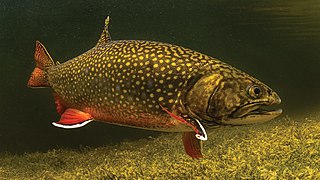
The brook trout is a species of freshwater fish in the char genus Salvelinus of the salmon family Salmonidae. It is native to Eastern North America in the United States and Canada, but has been introduced elsewhere in North America, as well as to Iceland, Europe, and Asia. In parts of its range, it is also known as the eastern brook trout, speckled trout, brook charr, squaretail, brookie or mud trout, among others. A potamodromous population in Lake Superior, is known as coaster trout or, simply, as coasters. Anadromous populations which are found in coastal rivers from Long Island to Hudson Bay are sometimes referred to as salters. The brook trout is the state fish of nine U.S. states: Michigan, New Hampshire, New Jersey, New York, North Carolina, Pennsylvania, Vermont, Virginia, and West Virginia, and the Provincial Fish of Nova Scotia in Canada.

Salvelinus is a genus of salmonid fish often called char or charr; some species are called "trout". Salvelinus is a member of the subfamily Salmoninae within the family Salmonidae. The genus has a northern circumpolar distribution, and most of its members are typically cold-water fish that primarily inhabit fresh waters. Many species also migrate to the sea.
The Marden House is a residence in McLean, Virginia designed by American architect Frank Lloyd Wright. It is located just off Chain Bridge Road and overlooks the Potomac River. Also known as "Fontinalis," it is named after Luis Marden (1913–2003), a writer, photographer, and explorer for National Geographic. It was designed by Wright in 1952 and was completed in 1959 at a cost of $76,000.

The splake or slake is a hybrid of two fish species resulting from the crossing of a male brook trout and a female lake trout. The name itself is a portmanteau of speckled trout and lake trout, and may have been used to describe such hybrids as early as the 1880s. Hybrids of the male lake trout with the female brook trout have also been produced, but are not as successful.

Harrimanella is a genus of flowering plant in the heath family Ericaceae, with a single species, Harrimanella hypnoides, also known as moss bell heather or moss heather. It was originally named Cassiope hypnoides by Linnaeus (1737) in his Flora Lapponica, but Harrimanella hypnoides is now the accepted name at Integrated Taxonomic Information System. The species name hypnoides means 'like Hypnum ', which is a genus mosses.

Atractophora hypnoides is a rare red alga (Rhodophyta) found in the British Isles, France and some Atlantic Islands and is the only species of the genus found in the British Isles. It is attached to the rock or other algae by a small basal disc and is much branched with downgrowing filaments which enclose the main branch or axis forming a cortex. Short filaments of limited growth radiate in whorls from the axis and frequently convert into hairs. The spreading filaments grow irregularly in a diffuse manner. Microscope examination is required for identification.
Telestes fontinalis, the Spring pijor, is a species of ray-finned fish in the family Cyprinidae. It is found only in Croatia. Its natural habitats are intermittent rivers and inland karsts. It is threatened by habitat loss.

Atractophora is a monotypic genus of red algae of the family Atractophoraceae. It only contains one known species Atractophora hypnoidesP.L.Crouan & H.M.Crouan, 1848.

Walchia is a primitive fossil conifer found in upper Pennsylvanian (Carboniferous) and lower Permian rocks of Europe and North America. A forest of in-situ Walchia tree-stumps is located on the Northumberland Strait coast at Brule, Nova Scotia.

Physa fontinalis, common name the common bladder snail, is a species of air-breathing freshwater snail, an aquatic gastropod mollusk in the family Physidae. The shells of species in the genus Physa are left-handed or sinistral.

Eragrostis hypnoides is a species of grass known by the common name teal lovegrass. It is native to the Americas from Canada to Argentina. It is found in moist areas near water in substrates of sand or mud.

Fontinalis is a genus of submerged aquatic mosses belonging to the subclass Bryidae. These mosses are also called fountain moss, brook moss and water moss. The genus is widespread in the Northern Hemisphere and includes both species that occur in still water and in flowing water.
Nebria fontinalis is a species of ground beetle in the Nebriinae subfamily that can be found in Italy and Switzerland.
Nebria fontinalis fontinalis is a subspecies of ground beetle in the Nebriinae subfamily that can be found in Italy and Switzerland.

Fontinalis antipyretica, greater water-moss, or common water moss, is a species of submerged aquatic moss belonging to the subclass Bryidae. It is found in both still and flowing freshwater in Europe, Asia, Greenland and Africa. In North America it is found in most Canadian provinces with a seaboard and most US states except the most southern.

Hercus fontinalis is a species of ichneumon wasp in the family Ichneumonidae. It is found in the United States and Europe.
Gnaphosa fontinalis is a species of ground spider in the family Gnaphosidae. It is found in the United States and Mexico.
Cercosaura hypnoides is a species of lizard in the family Gymnophthalmidae. It is endemic to Colombia.

Saxifraga hypnoides, called mossy saxifrage, cut-leaved saxifrage, Dovedale moss, Eve's cushion, Indian moss, lady's cushion, and queen's cushion, is a species of flowering plant in the family Saxifragaceae. It is native to northwestern Europe; Iceland, the Faroe Islands, Norway, Ireland, Great Britain, Belgium, and France, and has been introduced to Czechia, the Eastern Himalayas, and Tibet. In the north of its range a tetraploid form predominates, and in the south a diploid form is more likely to be found.











